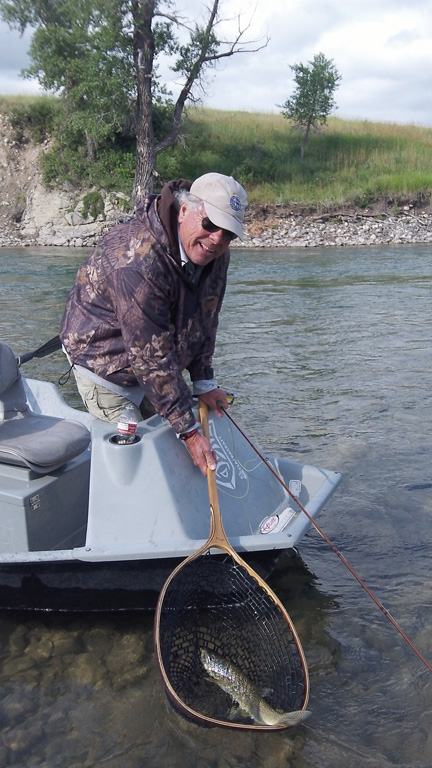Elk River
Jim Cote and Dennis Plummer on the Elk River
The Elk River originates from the melting ice off of the glaciers in Elk Lakes Provincial Park. As it makes its way down the mountains it flows into the Elk Lakes and down the Elk Valley, where it is joined by many tributaries that produce some amazing trout of their own. With over 90 miles of fishable water the Elk River is quite possibly the best dry fly fishing river in North America. Largely undiscovered and still only a three hour drive from Calgary and a two hour drive from Kalispell, the Elk River flows through one of the most picturesque valleys in British Columbia.
Whether you are a novice or expert, a trip to Fernie is something you’ll never forget. Casting to rising native Westslope cutthroat from our fully-appointed McKenzie style drift boats is one of the best ways to see the Elk but we also can arrange walk & wade trips to some of the smaller streams which are all located just a short distance from Fernie.
The small town of Fernie is surrounded by mountains on all sides and is often thought of as an alpine village which is famous for the skiing and the legendary powder. Fernie offers plenty in the way of restaurants, hotels and shops.
A double hook up on the Elk River
For more detailed information on the Elk River and to see a sample of a trip please visit our fly fishing the Elk River page.
A nice average Bull Trout from the Wigwam River
Whenever one of the guides get a day off there is a good chance that they will be found roaming around on the Wigwam River. This is arguably the most beautiful river in the west. The multi colored polished stones on the river bottom shimmer though the gin clear waters. As the stream cuts back and forth it digs deep pools and creates a perfect habitat for the large native bull trout and cutthroat trout. This river is a tributary to the Elk River but on average has larger trout than any other stream in the Kootenays.
Your day on the Wigwam will be spent walking between pools, fishing riffles and often sight casting to rising trout. The hatches on the Wigwam are incredible and very reliable as well. The drake hatch seems to last weeks and almost every day you can count on something emerging regardless of weather conditions.
The Wigwam River also has the largest run of bull trout in the west with thousands migrating upstream to spawn in the fall. As these monsters spend the summer months in the river they are often caught on streamers and even dry flies at times. Every year several of our clients hook bull trout over 10 pounds on the dry fly. During the 2007 season we actually guided 17 different anglers into bull trout over 27 inches on dry flies. Since the Wigwam is only a short drive from Fernie we run this as a day trip.
The pre spawing colors of a Bull Trout caught on the Wigwam River
Waterton River
A nice Waterton River brown taken on a dry fly
We both float this river and we walk and wade it in the fall as water levels drop. While the rainbow fishing can be quite good it’s really the browns that we target on this stream. Don’t expect huge numbers but you can expect to have some great shots at huge browns.
The Waterton is a smaller stream but the holding water is incredible. Every bend in the river offers great water for both the trout and the angler. The scenery rivals any river I have ever been on and the hatches give us the opportunity to work dry flies almost every day.
We have three floats on the Waterton River with two private launches. We usually package this with the St.Mary River in Alberta which you can also read about. This makes for an awesome 2-3 day trip and we stay in either Cardston Alberta or right in Waterton National Park. The park offers great restraunts and accommodations.
Both the Waterton and St. Mary Rivers fish best in July and September. This is a trip that you really won’t want to miss out on. Over the last few years it has become a favorite for our guests.
July is the best time of year to float this great river. We fish just outside of Waterton National Park
St. Mary River
A typical rainbow from the St.Mary River
We have been guiding this stream for ten years now and I have to admit that it’s still my personal favorite. The challenge and the size of rainbows is not for every angler but for those that are looking for a real challenge there is no better place to do it.
Last season we saw rainbows up to 27 inches caught on the dry fly and the hopper fishing in late July was really something to see. This river can really make an angler look bad when it comes to keeping fish on the line. The rainbows here can reach ten pounds and the fighting ability of these brutes is legendary. Even very experienced anglers are lucky to land half of the fish they hook.
We float the St. Mary in July and even late June. After August 1st the water becomes too low to float most years however the walking is easy and this does allow us some sight fishing opportunities.
We generally combine this trip with a day on the Waterton River and we prefer to base these trips out of Waterton National Park.
The hatches here are diverse and prolific. As our season begins and the water remains slightly cloudy, Salmon flies begin to pop off in large numbers along the rocky banks of the river. As they return or fall to the water, the native cutthroats begin hammering these bulky insects with reckless abandon. Plump Green Drakes also begin their ascent to the surface early in the season and pools will boil and “pop” as rising trout aggressively feed on these large mayflies. More intense than the Salmon fly, the golden stones begin making their appearance usually 2 weeks after the Salmon fly emergence. These awkward flyers leave their nymphal forms along the dry rocks of the riverbank and literally paint the rocks with their dry mottled shucks. The early season is not to be missed if large flies and crushing takes is your preference.
Hoppers and beetles make for great dry fly fishing in August
As we move further into summer, ever present caddis swarm in thickets close to the bank and smaller stones (yellow/lime sallies) begin their mid-day flights. This is also the time for the Elk River’s famous P.M.D. hatch. You can pretty much set your watch to these hatches and the spinner falls are a spectacle in the evening light. More delicate approaches are the rule here and sunken spinner presentations or soft-hackling will prolong the productivity of this hatch
Terrestrials become important as the summer sun warms the river and the winds blow hoppers from grassy, overhanging banks. This presentation requires strong heart over skill as often fish explode on hopper imitations which are skittering atop the surface. Terrestrials remain solid into the early autumn and one may find themselves hooking fish on a no. 8 foam hopper at the start of the day and then casting a no. 20 Baetis emerger to an aquarium of rising fish as the day progresses. Autumn also sees a number of Flavs (lesser green drakes) and October Caddis emerging from the gin-clear waters.
We are truly blessed some with excellent hatches and as guides we are able to really jump around the boxes to suit the different hatches that can occur within one day. It is not uncommon to fish a hatch in which one fish will be selectively rising to a carpet of Baetis while a foot away another sips exclusively on Flavs. Due to the varying elevations of our streams, you can fish the same hatch that spent itself two weeks earlier in a lower drainage on a high mountain stream and in essence follow the hatch.








